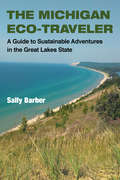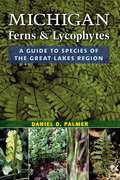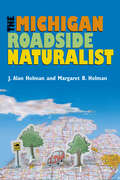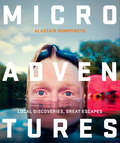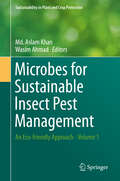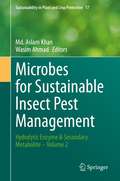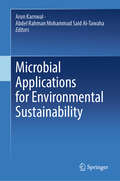- Table View
- List View
The Michigan Eco-Traveler: A Guide to Sustainable Adventures in the Great Lakes State
by Sally BarberMichigan offers some of the most wonderfully diverse recreation opportunities in the country. The Michigan Eco-Traveleris for a new and growing breed of leisure traveler and adventurer—the individual seeking to experience the pleasant peninsulas responsibly by minimizing his or her eco-footprint. The book introduces readers to the importance of eco-friendly travel and highlights some of the best eco-conscience venues across the state that offer activities from golfing to skiing to sailing and much more. The book also examines environmental pressures on the state’s recreational resources, revealing the critical need for joining together in conservation practices, and offers travelers helpful tips for evaluating the sustainability of their own favorite recreational spots. Whether you’re a weekend traveler, extreme adventurer, or family on vacation, The Michigan Eco-Travelerlights the way to a greener getaway. Naturalists, conservationists, and hospitality experts will find the book equally helpful in responding to the ever rising demand for sustainable recreation.
Michigan Ferns and Lycophytes: A Guide to Species of the Great Lakes Region
by Daniel D PalmerMichigan’s ferns and lycophytes are among the state’s most fascinating plants. The species in these groups exhibit incredibly diverse life cycles and an amazing array of morphology. Some species such as the Bracken fern are widespread and aggressive, dominating forest understories throughout much of northern Michigan, while other species are exceedingly rare and adapted to life solely in harsh niche habitats where little else can grow. Unlike the well-studied flowering plants and gymnosperms, Michigan’s ferns and lycophytes have long lacked a reliable, up-to-date guidebook, and this book fills that gap. Covering all 120 taxa found in the state, it features detailed keys, species descriptions, and range maps alongside precise illustrations. Readers learn about the etymology of species’ common and scientific names as well as interesting facts about their historic uses by humans and place within the Michigan ecosystem. The book also provides information on the challenging taxonomy of many ferns and lycophytes, with special attention given to the species likely to hybridize and those prone to misidentification. This is a must-have reference for anyone who wishes to learn about these important components of the Great Lakes flora.
The Michigan Roadside Naturalist
by J. Alan Holman Margaret B. HolmanDid you know . . . ? Michigan is seventeenth in oil production in the United States. The Great Lakes are said to be the only glacially produced structures that can be seen from the moon. Michigan was once part of a coral reef. The wood frog is one of the commonest true frogs of moist woodland floors in Michigan today and is able to freeze solid during the winter without harmful effects. These and many more amazing facts await the curious traveler in The Michigan Roadside Naturalist, J. Alan and Margaret B. Holman's captivating guide to the natural treasures of Michigan. A perfect accompaniment to the classic Michigan Trees and The Forests of Michigan, this user-friendly guide offers a Who's Who of the geology, biology, and archaeology of the Great Lakes State, as well as highway adventures along the state's major routes. The book begins with an educational yet accessible tour of important points in Michigan's natural and archaeological history, followed by seven road trips based on commonly traveled state routes, moving from south to north in the Lower Peninsula and east to west in the Upper Peninsula. Readers can proceed directly to the road trips or familiarize themselves with the state's treasure trove of fascinating features before embarking. Either way, an informative and fun odyssey awaits the passionate naturalist, amateur or otherwise. J. Alan Holman is Curator Emeritus of Vertebrate Paleontology at the Michigan State University Museum and Emeritus Professor of Geology and Zoology at Michigan State University. Margaret B. Holman is Research Associate at Michigan State University Museum and Department of Anthropology, Michigan State University.
Michigan Shrubs and Vines: A Guide to Species of the Great Lakes Region
by Burton V. Barnes Christopher E Dick Melanie W GunnShrubs and vines are some of the most diverse and widespread plants in the Great Lakes Region. Michigan Shrubs and Vines is the must-have book for anyone who wishes to identify and learn about these fascinating plants. Presented in the same attractive, easy-to-use format as the classic Michigan Trees, the book gives detailed descriptions of 132 species, providing concise information on key characters, habitat, distribution, and growth pattern. Precise line drawings accompany each species description and illustrate arrangement and characteristics of leaves, flowers, and fruits in addition to stem structure to assist with reliable year-round identification. A thorough introduction covers the features and forms of shrubs and vines as well as their natural history, their role in landscape ecosystems, and their occurrence in regional ecosystems of North America and plant communities of the Great Lakes. This long awaited companion to Michigan Trees will appeal to botanists, ecologists, students, and amateur naturalists alike.
Micro-Behavioral Economics of Global Warming: Modeling Adaptation Strategies in Agricultural and Natural Resource Enterprises (Advances in Global Change Research #60)
by S. Niggol SeoThis book presents a foundation for studying the micro-behavioral economics of global warming. The author develops an empirical model, named the Geographically-scaled Micro econometric model of Adapting Portfolios (G-MAP) in response to climatic changes and risks. The G-MAP model is applied to observed decisions of agricultural and natural resource enterprises in Sub-Saharan Africa and South America. The author describes the five applications of the model: the G-MAP animal species, the G-MAP agricultural systems, the G-MAP natural resource enterprises, the G-MAP climate risk, and the G-MAP public adaptations.The micro-behavioral economics of global warming and the G-MAP models are evaluated against the three alternative modeling traditions: The first is the Agro-Economic Models (AEM) based on crop simulations of selected crops under elevated CO2 conditions; The second is a family of econometric studies of grain yield changes caused by yearly weather fluctuations; The third is the Agro-Ecological Zone (AEZ) method hinged crucially on the AEZ classifications of ecosystems. The author offers a refreshing look at the traditional economics of global warming, unraveling a broad array of adaptation strategies adopted by managers of agricultural and natural resource enterprises in Sub-Saharan Africa and South America. The book demonstrates that the micro-behavioral economics dynamically integrates multiple disciplines in a cohesive way - including economics, psychology, climate science, ecosystem studies, agronomy and animal science - into the decision-making framework of an individual agent. The G-MAP models provide a guide map of adaptation strategies for the humanity’s enduring journey of battling global climatic changes in this century and beyond.
Micro-Pollutant Regulation in the River Rhine: Cooperation in a Common-Pool Resource Problem Setting
by Laura Mae HerzogThis book investigates how actors organize in order to solve a water quality problem. Research on the use of environmental resources has mainly focused on the circumstances needed for users to self-organize or to maintain an already sustainable way of resource use. Few studies have investigated the reasons why actors start to cooperate when they are faced with an environmental problem. Actor networks in three regions of the Rhine catchment area are scrutinized regarding a) actors’ cooperation pattern when managing an environmental problem; and b) the factors that trigger actors in a common-pool resource situation to initiate cooperation. Water quality policy is analysed in two European countries – Germany and Luxembourg – and one non-European country - Switzerland –, providing an overview of the distinctive measures applied in these regions aiming to tackle the water quality problem of micro-pollutants in river surface water. Applying the social-ecological system framework (SESF) devised by E. Ostrom and her colleagues and Social Network Analysis (SNA), the current book combines qualitative and quantitative methods to answer the question of why actors cooperate in the management process of an environmental problem like water pollution.
Microadventures: Local Discoveries For Great Escapes
by Alastair Humphreys‘Enthusiastic, pleasingly madcap’ Geographical Adventure – something that’s new and exhilarating, outside your comfort zone. Adventures change you and how you see the world, and all you need is an open mind, bags of enthusiasm and boundless curiosity. Recommended for viewing on a colour tablet.
Microalgae: From Future Food to Cellular Factory
by Joel FleurenceMicroalgae and cyanobacteria are the first organisms in the oceanic food chain and are essential producers of oxygen and effective carbon dioxide traps. They are traditional sources of food proteins for Aztec, African and Asian populations, and some of them have even acquired the status of superfoods. Microalgae reviews the biological, ecological and biochemical characteristics of microalgae and cyanobacteria. They are true cellular factories, producing substances of interest such as original pigments, proteins and polysaccharides with biological activities. Their use covers many sectors of human activity including aquaculture, livestock breeding, agri-food, and human and veterinary medicine.This book presents their mode of production and the transformation processes that are applied to them, as well as the traditional and future valorization of algae. As they are a source of lipids and fatty acids, microalgae have become the focus of attention for the development of green fuels, such as biofuel.
Microalgae: From Future Food to Cellular Factory
by Joel FleurenceMicroalgae and cyanobacteria are the first organisms in the oceanic food chain and are essential producers of oxygen and effective carbon dioxide traps. They are traditional sources of food proteins for Aztec, African and Asian populations, and some of them have even acquired the status of superfoods. Microalgae reviews the biological, ecological and biochemical characteristics of microalgae and cyanobacteria. They are true cellular factories, producing substances of interest such as original pigments, proteins and polysaccharides with biological activities. Their use covers many sectors of human activity including aquaculture, livestock breeding, agri-food, and human and veterinary medicine.This book presents their mode of production and the transformation processes that are applied to them, as well as the traditional and future valorization of algae. As they are a source of lipids and fatty acids, microalgae have become the focus of attention for the development of green fuels, such as biofuel.
Microalgal Bioengineering
by Jorge Alberto Vieira Costa Brian Gregory Mitchell John BenemannThis book presents recent advances, challenges, and trends in modern microalgal biotechnology. It covers microalgae genetics, bioreactors, modeling, massive scale and industrial cultivation, and environmental, social, and economic aspects of microalgal biotechnology. The book also explores the emerging knowledge about high-value bioproducts from microalgae, e.g., biofuels, biosurfactants, bioremediation, bioplastics/biopolymers, pharmaceuticals, antioxidants (anti-aging), fatty acids, polysaccharides and proteins, feed and superfoods with microalgae. The chapters will be written by prominent professors and researchers from the six inhabited continents of the world, from academic to industrial sectors.
Microalgal Production for Biomass and High-Value Products
by Stephen P. Slocombe John R. BenemannMicroalgae are a particularly interesting source of products that range from currently marketed human nutritionals and food ingredients, to potential sources of biofuels and animal feeds. Rapid advances in technology and commercial development are taking place worldwide. Importantly, algal cultivation does not compete with agriculture for land, water, and in some cases, fertilizer resources. Microalgal Production for Biomass and High-Value Products covers the field from a variety of perspectives with 14 chapters contributed by recognized academic experts and industrial practitioners. The book presents the latest technologies and innovations in algal biomass production, from cultivation in open ponds and photobioreactors, to strain selection, synthetic biology, pest control, harvesting, and processing. It explores novel algal products and addresses key issues, including markets, supply chains, business strategies, legal issues, current products, and future prospects. This book brings together the latest advances of interest to those already working in the field while providing an introduction to those beginning to learn about the promise of microalgae as a sustainable source of both specialty and commodity products. It gives stimulating overviews from many different perspectives that describe how laboratory and applied research are creating advances in commercial microalgae production. It also addresses the still many open questions and challenges in this field.
Microalgal Production for Biomass and High-Value Products
by Stephen P. Slocombe John R. BenemannMicroalgae are a particularly interesting source of products that range from currently marketed human nutritionals and food ingredients, to potential sources of biofuels and animal feeds. Rapid advances in technology and commercial development are taking place worldwide. Importantly, algal cultivation does not compete with agriculture for land, water, and in some cases, fertilizer resources. Microalgal Production for Biomass and High-Value Products covers the field from a variety of perspectives with 14 chapters contributed by recognized academic experts and industrial practitioners. The book presents the latest technologies and innovations in algal biomass production, from cultivation in open ponds and photobioreactors, to strain selection, synthetic biology, pest control, harvesting, and processing. It explores novel algal products and addresses key issues, including markets, supply chains, business strategies, legal issues, current products, and future prospects. This book brings together the latest advances of interest to those already working in the field while providing an introduction to those beginning to learn about the promise of microalgae as a sustainable source of both specialty and commodity products. It gives stimulating overviews from many different perspectives that describe how laboratory and applied research are creating advances in commercial microalgae production. It also addresses the still many open questions and challenges in this field.
Microbes: The Unseen Agents of Climate Change
by David L. KirchmanFor billions of years, microbes have produced and consumed greenhouse gases that regulate global temperature and in turn other aspects of our climate. The balance of these gases maintains Earth's habitability. Methane, a greenhouse gas produced only by microbes, may have kept Earth out of a deep freeze billions of years ago. Likewise, variations in carbon dioxide, another greenhouse gas released by microbes and other organisms, help to explain the comings and goings of ice ages over the last million years. Now we face a human-made climate crisis with drastic consequences. The complete story behind greenhouse gases, however, involves microbes and their role in natural ecosystems. Microscopic organisms are also part of the solution, producing biofuels and other forms of green energy which keep fossil fuels in the ground. Other microbes can be harnessed to reduce the release of methane and nitrous oxide from agriculture, and geoengineering solutions that depend on microbes could pull carbon dioxide out of the atmosphere. In this book, David L. Kirchman introduces a unique and timely contribution to the climate change conversation and the part microbes play in our past, present, and future. He takes readers into the unseen world behind the most important environmental problem facing society today and encourages us to embrace microbial solutions that are essential to mitigating climate change.
Microbes: The Unseen Agents of Climate Change
by David L. KirchmanFor billions of years, microbes have produced and consumed greenhouse gases that regulate global temperature and in turn other aspects of our climate. The balance of these gases maintains Earth's habitability. Methane, a greenhouse gas produced only by microbes, may have kept Earth out of a deep freeze billions of years ago. Likewise, variations in carbon dioxide, another greenhouse gas released by microbes and other organisms, help to explain the comings and goings of ice ages over the last million years. Now we face a human-made climate crisis with drastic consequences. The complete story behind greenhouse gases, however, involves microbes and their role in natural ecosystems. Microscopic organisms are also part of the solution, producing biofuels and other forms of green energy which keep fossil fuels in the ground. Other microbes can be harnessed to reduce the release of methane and nitrous oxide from agriculture, and geoengineering solutions that depend on microbes could pull carbon dioxide out of the atmosphere. In this book, David L. Kirchman introduces a unique and timely contribution to the climate change conversation and the part microbes play in our past, present, and future. He takes readers into the unseen world behind the most important environmental problem facing society today and encourages us to embrace microbial solutions that are essential to mitigating climate change.
Microbes and Enzymes in Soil Health and Bioremediation (Microorganisms for Sustainability #16)
by Ashok Kumar Swati SharmaMicrobial enzymes play a vital role in maintaining soil health and removing pollutants from contaminated land. Soil microflora is closely associated with maintaining soil fertility, and the use of chemical pesticides, fertilizers and other volatile sprays in agriculture threatens the health ofthe microbial population in the soil. Every single particle of healthy soil contains millions of bacteria, which interact with the nutrients available, sustaining the nutrient cycle and making this microflora an essential component of life on earth. How do microbes help in the nutrient cycle? Either by intracellular digestion of macromolecules and converting these into smaller units in their metabolic pathways, or by secreting enzymes into the extracellular environment to facilitate the conversion of complex macromolecules into micro-molecules that can be easily absorbed by other living species. To meet demands for energy and food for the growing global population, it is important to protect agricultural land from contamination and maintain its productivity. Heavy metal ions from contaminated land canenter crops, fish or aquatic organismsvia contaminated water, and theseare then taken up by the human body, where they can accumulate and alter the normal microflora.The microbiological component of the soil is ahighly complex system and is still not fully understood. How do microbes survive in the changing physicochemical environment of soil?. This book helps readers understand the mechanism, various routes of microbialsoil remediation, the interactionsof different genera, and how microbial enzymes support the sustainable restoration of healthy soil.
Microbes for Sustainable Insect Pest Management: An Eco-friendly Approach - Volume 1 (Sustainability in Plant and Crop Protection)
by Md. Aslam Khan Wasim AhmadThis Volume comprises 14 chapters in an attempt to provide the reader with available information on safe and effective use of entomopathogens. Chapters in this book dealing with soil-borne entomopathogens and their phylogeny also provide a review on most updated information of their isolation and molecular identification. Employing fungal pathogens in biological control programmes plays a key role, and conidial thermotolerance and oxidative stress are examined in separate chapters. Entomopathogenic bacteria are able to kill their hosts quickly. An important contribution concerns informations provided upon bacterial cytotoxic factors on insect haemocytes. Nematodes are biological control agents safe to the environment. The information with respect to their direct and indirect effects on non-target organisms is provided. Viruses as highly specific, virulent candidates for use as biological insecticides are safe to non-target species. A separate chapter on the role of granuloviruses in IPM contributes a wealth of information. Biopesticides in combination with synthetic insecticides are reported as effective, economic, and eco-friendly. Understanding their interactions will certainly promote their uses. Finally, emphasis has been given on reviewing synergistic and antagonistic interactions of microbial and chemical pesticides, in other chapters.
Microbes for Sustainable lnsect Pest Management: Hydrolytic Enzyme & Secondary Metabolite – Volume 2 (Sustainability in Plant and Crop Protection #17)
by Md. Aslam Khan Wasim AhmadThe search for new strategies of pest control with safer molecules is currently of great importance and interest. Microbe-mediated biological crop protection is an attractive and promising technology with no concern for a negative impact on the environment and biodiversity. Microbial hydrolytic enzymes such as proteases, chitinases, lipases, etc. are attractive for this purpose. They present toxic properties and act synergistically to control pest attacks. Also, some metabolites, that microorganisms produce for their survival or defense, can be explored and exploited for plant protection. The focus of this Volume is on the potential of microbial hydrolytic enzymes and their metabolites in agroecosystem functioning. Subsequent chapters review topics such as microbial hydrolytic enzymes as powerful management tools, chitinases in IPM of agro-horticultural crops, metabolites as pesticides and the importance of the metabolites of entomopathogenic fungi, metabolites and virulence factors. Other topicas include: microbial-based nanoparticles, recombinant DNA technologies to improve the efficacy of microbial insecticides, the effects of entomopathogens on insect predators and parasitoids, and the management of major vegetable insect pests. This Volume provides detailed accounts on the safe use of microbial products for sustainable management of insect pests. Its aim is to build solid foundations for the students, teachers, and researchers interested in eco-friendly management of important insect crop pests.
Microbial Activity in the Rhizosphere (Soil Biology #7)
by Krishna Gopal Mukerji C. Manoharachary Jagjit SinghThe rhizosphere is a very complex environment in which the effects of the plant on soil microorganisms and the effects of the microorganisms on the plant are interacting and are interdependent. Plant root exudates and breakdownproducts attract microbes and feed them and, in turn, the plants often bene?t from the microbes. Interactions among microorg- ismsandplantrootsareessentialfornutritionalrequirementsoftheplant. Plant growth, development and productivity are largely dependent on the soil environment in the root region rhizosphere. The new techniques of studying the rhizosphere enables us to get a much better understanding of the dynamics of the rhizosphere population, such rhizosphere studies beingofinteresttoagriculturists,soilbiologists,chemists,microbiologists andmolecularbiologists. The rhizosphere microbes in?uence the root environment in several ways. They may change the oxidation-reduction potential, in?uence the availabilityofmoistureandnutrients,producegrowthinhibitingorgrowth promoting substances in the form of exudates, provide competition and possiblyinducemanyothereffects.Mycorrhizalassociationsarebene?cial in mineral uptake and in increasing root surface area for effective ion absorption. Antagonism,competitionandsynergisminsoilandtherhizoplane(r- zosphere) are the most important microbial interactions to consider in the study of rhizosphere biology. With the growing information on the production of growth regulators, competitiveness of the microbes in the rhizosphere, microsymbionts, and other factors, their effect upon plant growth will become more evident. Experiments on the introduction of microbes or their products in the rhizosphere will help to improve our understandingofthebiologyoftherhizosphere.
Microbial Applications for Environmental Sustainability
by Arun Karnwal Abdel Rahman Mohammad Said Al-TawahaThis book focuses on the various applications of microorganisms for sustainable environment and the reduction of hazardous pollutants released in various forms, including xenobiotics, e-waste, pesticides, insecticides, plastic, heavy metals, paper waste, medical waste, textile dyes, and their impact on environmental and human health. The book involves a series of research reports that explain the application of microbes used to solve real-life issues raised due to changes happening in environment, including pollution, by covering applications, including the use of bacteria, fungi, microalgae and biofilm in the detection and degradation of crude oil, pesticides, dyes, e-waste, heavy metals and other pollutants. It also focuses on integrative strategies in the application of microbial nanomaterials for remediation of pollutant. This material will help environmental scientists and microbiologists to learn about existing environmental problems and suggest novel ways to control or contain their effects by employing various treatment approaches.
Microbial Biofilms: Applications and Control
by Naga Raju Maddela Aransiola Sesan AbiodunMicrobial biofilms have both positive and negative effects. This book considers new ways of controlling environmental microbial biofilm such as using phages, nanotechnology, and newly discovered microbial enzymes. A team of contributors shares current, relevant and original research to add weight and recognition to the book. Also, each chapter provides enlightening and relevant tabular information, charts, and illustrations. The book is, therefore, informative, precise, useful and easily digested by users.
Microbial Biofilms: Applications and Control
by Naga Raju Maddela Aransiola Sesan AbiodunMicrobial biofilms have both positive and negative effects. This book considers new ways of controlling environmental microbial biofilm such as using phages, nanotechnology, and newly discovered microbial enzymes. A team of contributors shares current, relevant and original research to add weight and recognition to the book. Also, each chapter provides enlightening and relevant tabular information, charts, and illustrations. The book is, therefore, informative, precise, useful and easily digested by users.
Microbial Ecology: Microbiomes, Viromes, and Biofilms
by Bhagwan Narayan RekadwadThis book highlights the hidden world of microbiomes, viromes, and biofilms on and inside humans. Our bodies have microbiomes, which contain various bacterial communities, and viromes, which contain viruses. These invisible residents are vital to health and sickness. Infections often result from microbiome imbalances. Pathogenic bacteria can outcompete beneficial ones, causing gut dysbiosis and disease. Understanding this interaction allows probiotics to restore balance and fight infections. Microbes have a major impact on the gut-brain axis. Gut bacteria affect mood, behavior, and neurodegenerative illnesses by producing neurotransmitters and influencing brain development. The "diabesity" relationship to microbiome changes underscores its relevance in metabolic illnesses like diabetes and NAFLD. The microbiota can also affect cancer progression. Specific bacterial strains may promote tumor growth or prevent metastasis, enabling microbiome-based cancer treatments. Probiotics—live bacteria—have enormous potential. Beneficial strains can improve intestinal balance, fight infections, and treat diabetes and autoimmune conditions.Fecal transplants or co-sleeping may modify microbial ecosystems and health effects. Microbiomes, viromes, and biofilms are complex, requiring advanced tools. The makeup, function, and interactions of these communities can be characterized using next-generation sequencing (NGS). As NGS technology advances, researchers explore this hidden world, offering a future where microbiome manipulation underpins customized therapy and preventive healthcare. This area has great potential for understanding health, improving well-being, and fighting diseases in innovative ways.
Microbial Ecology: Microbiomes, Viromes, and Biofilms
This book highlights the hidden world of microbiomes, viromes, and biofilms on and inside humans. Our bodies have microbiomes, which contain various bacterial communities, and viromes, which contain viruses. These invisible residents are vital to health and sickness. Infections often result from microbiome imbalances. Pathogenic bacteria can outcompete beneficial ones, causing gut dysbiosis and disease. Understanding this interaction allows probiotics to restore balance and fight infections. Microbes have a major impact on the gut-brain axis. Gut bacteria affect mood, behavior, and neurodegenerative illnesses by producing neurotransmitters and influencing brain development. The "diabesity" relationship to microbiome changes underscores its relevance in metabolic illnesses like diabetes and NAFLD. The microbiota can also affect cancer progression. Specific bacterial strains may promote tumor growth or prevent metastasis, enabling microbiome-based cancer treatments. Probiotics—live bacteria—have enormous potential. Beneficial strains can improve intestinal balance, fight infections, and treat diabetes and autoimmune conditions.Fecal transplants or co-sleeping may modify microbial ecosystems and health effects. Microbiomes, viromes, and biofilms are complex, requiring advanced tools. The makeup, function, and interactions of these communities can be characterized using next-generation sequencing (NGS). As NGS technology advances, researchers explore this hidden world, offering a future where microbiome manipulation underpins customized therapy and preventive healthcare. This area has great potential for understanding health, improving well-being, and fighting diseases in innovative ways.
Microbial Ecosystems in Central Andes Extreme Environments: Biofilms, Microbial Mats, Microbialites and Endoevaporites
by María Eugenia FaríasThe Central Andean Altiplane represents a unique extreme environment due to its high altitude, closed basins that modulate the salt pans and saline wetlands surrounded by deserts, as well as the considerable influence of volcanic activity. UV radiation, arsenic content, high salinity, alkalinity and low dissolved oxygen levels, together with extreme daily temperature fluctuations and oligotrophic conditions, shape an environment that resembles the early Earth and, even more, extraterrestrial conditions. By developing simple biofilms stratified microbial mats or complex microbialites, extreme microbial ecosystems, colonize and thrived in different environments like salt flats, wetlands, lakes volcano vents, geysers and deserts. This book presents our current understanding of these amazing ecosystems, providing a basis for their protection and sustainable utilization. The main audience for this book included researchers and graduate students as well as professionals working in the government, mining industry and similar activities.
Microbial Growth on C1 Compounds: Proceedings of the 8th International Symposium on Microbial Growth on C1 Compounds, held in San Diego, U.S.A., 27 August – 1 September 1995
by Mary E. Lidstrom F. Robert TabitaThe 8th International Symposium on Microbial Growth on C1 Compounds was held at the Bahia Resort Hotel, San Diego, CA, 27 August-1 September, 1995. A total of 160 participants from 18 countries were registered. Eight Scientific Sessions were held in which 45 papers were presented, and 114 posters were displayed and discussed in 3 separate poster sessions. The Symposium covered a broad range of topics, including acetogenesis, methanogenesis, CO2 fixation, lithoautotrophy, carboxidotrophy, methylotrophy and methanotrophy. The theme of the Symposium was mechanistic, and under this rubric the physiology, biochemistry, molecular biology, and both applied and environmental aspects of microbial growth on C1 compounds were addressed. This Symposium Volume contains 46 chapters, including the text of an Opening Address delivered at the Symposium by J.R. Quayle. This chapter elegantly presents an historical perspective on the past 7 Symposia, in the context of major breakthroughs in the field and of what is termed `giant' topics. The reader will be pleased to see that the tradition of the past Symposia Volumes is upheld, and that both familiar and new `giant' topics are covered. This Volume presents a cutting edge view of the broad field of microbial one-carbon metabolism, and provides a valuable resource for researcher and student alike.
